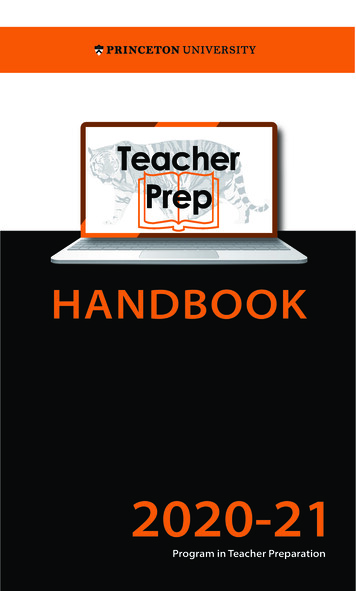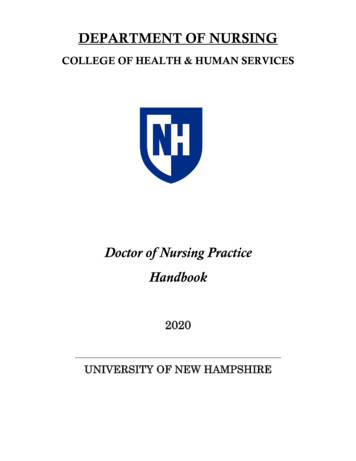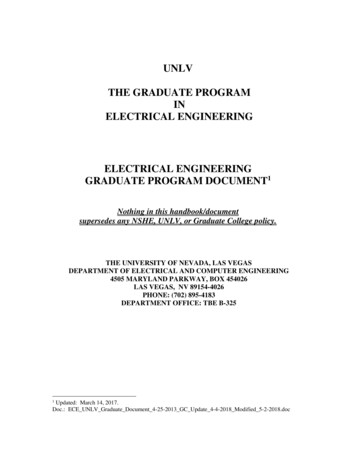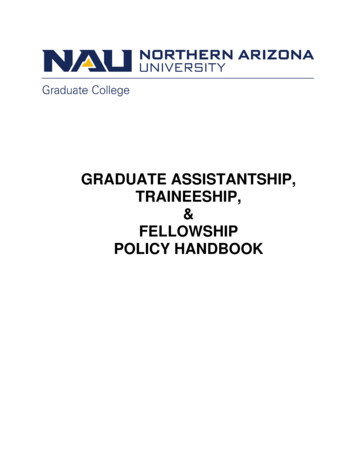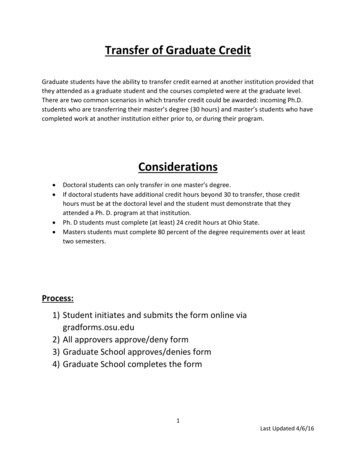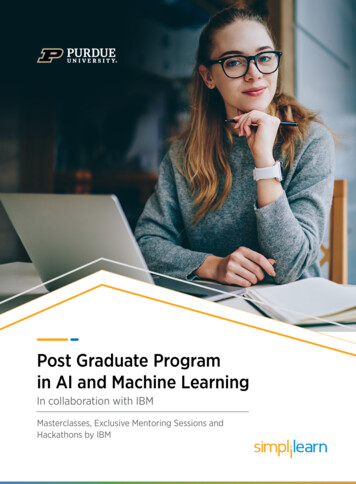
Transcription
Post Graduate Programin AI and Machine LearningIn collaboration with IBMMasterclasses, Exclusive Mentoring Sessions andHackathons by IBM1 www.simplilearn.com
About the Program 03TableofContentsKey Features of the Post Graduate Program inAI and Machine Learning in partnership withPurdue University 04About the Post Graduate Program in AI andMachine Learning in partnership withPurdue University 05About Simplilearn 05Program Eligibility Criteria andApplication Process 06Learning Path Visualization 08Program Outcomes 09Who Should Enroll in this Program11CoursesStep 1 - Programming Refresher12Step 2 - Introduction to AI13Step 3 - Statistics Essential14Step 4 - Python for Data Science16Step 5 - Data Science with Python17Step 6 - Machine Learning19Step 7 - Deep Learning with Tensorflow and Keras21Step 8 - Advanced Deep Learning and Computer Vision22Step 9 - AI and Machine Learning Capstone Project23Electives 24Certification 25Advisory Board Members 262 www.simplilearn.com
Aboutthe ProgramArtificial intelligence (AI) and machinelearning are among the most sought afterand highly compensated digital economyskills. Accelerate your career with ouracclaimed Post Graduate Program in AIand Machine Learning in partnership withPurdue University and in collaborationwith IBM. This program features theperfect mix of theory, case studies, andextensive hands-on practice in artificialintelligence education, leveraging Purdue’sacademic excellence and Simplilearn’spartnership with IBM.This post graduate program is a blendof self-paced online videos, live virtualclasses, hands-on projects, and GPUenabled labs. Mentorship sessions willprovide you with a high-engagementlearning experience and real-worldapplications, helping you master essentialAI and machine learning skills. You willreceive in-depth exposure to AI conceptsand workflows, Python, machine learning,deep learning concepts using TensorFlowand Keras, computer vision, GANs,parallel and distributed computing usingGPUs, and more. You will learn how todeploy deep learning models in variousenvironments, such as Kubernetes andDocker, the basics of natural languageprocessing (NLP), speech recognition, anddeep reinforcement learning, which willprepare you for an exciting career inAI and machine learning.3 www.simplilearn.com
Key Features of the Post GraduateProgram in AI and Machine Learningin Partnership with Purdue UniversityPurdue PostGraduate ProgramCertificationPurdue AlumniAssociationmembershipIndustry-recognizedIBM certificates forIBM courses25 hands on projectson integrated labs450 hours ofApplied LearningCapstone project in3 DomainsMasterclasses fromExclusive MentoringTop Purdue FacultySessions andand Industry ExpertsHackathons by IBMSimplilearn JobAssistance withIIMJobs (India Only)at IBMSimplilearn CareerService from Talent Inc.(U.S only)4 www.simplilearn.com
About the Post Graduate Program inAI and Machine Learning in partnershipwith Purdue UniversityThis Post Graduate Program inAI and Machine Learning is inpartnership with Purdue University,one of the world’s leading researchand teaching institutions with over150 years of academic excellence,offering higher education at itshighest proven value. Committed tostudent success, Purdue is changingthe student experience with a greaterfocus on faculty-student interactionand creative use of technology.Upon successfully completing thisprogram, you will:Receive a Purdue certification ofcompletionBecome entitled for membershipin the Purdue University AlumniAssociationThis program is designed to prepareyou to kickstart your career inArtificial Intelligence, MachineLearning, and Deep Learning.About SimplilearnSimplilearn is the world’s #1 online bootcamp provider that enables learners throughrigorous and highly specialized training. We focus on emerging technologies andprocesses that are transforming the digital world, at a fraction of the cost and time astraditional approaches. Over one million professionals and 2000 corporate trainingorganizations have harnessed our award-winning programs to achieve their career andbusiness goals.5 www.simplilearn.com
Program Eligibility Criteria andApplication ProcessThose wishing to enroll in the Post Graduate Program in AI and MachineLearning in partnership with Purdue University will be required to applyfor admission.Eligibility CriteriaFor admission to the Post Graduate Program in AI and Machine Learning,candidates should have:A bachelor’s degree with an average of 50% or higher marksBasic understanding of programming concepts and mathematicsWorking Professionals with 2 years of experience are preferred toapply for this programApplication ProcessThe application process consists of three simple steps. An offer ofadmission will be made to the selected candidates and accepted by thecandidates upon payment of the admission fee.STEP 1SUBMIT ANAPPLICATIONSTEP 2APPLICATIONREVIEWSTEP 3ADMISSIONComplete the applicationAfter you submit yourAn offer of admission will beand include a brief statementapplication, a panel ofmade to qualified candidates.of purpose to tell ouradmissions counselors willYou can accept this offer byadmissions counselorsreview your application andpaying the program fee.why you’re interestedstatement of purpose toand qualified for the Postdetermine your qualificationsGraduate Program in AI andand interest in the program.Machine Learning.6 www.simplilearn.com
Talk to an Admissions CounselorWe have a team of dedicated admissions counselors who are hereto help guide you in the application process and related matters.They are available to:Address questions related to the applicationAssist with financial aid (if required)Help you better understand the program and answer your questions7 www.simplilearn.com
Learning Path1Programming Refresher2Introduction to AI3Statistics Essential4Python for Data Science5Data Science with Python6Machine Learning7Deep Learning with Tensorflow and Keras8Advanced Deep Learning and Computer Vision9AI and Machine Learning Capstone ProjectMaster's Certificate1Natural Language Processing and Speech Recognition (Electives)2Reinforcement Learning (Electives)3Git and Github Training (Electives)4Master class- Purdue University (Electives)5Industry Master Class- Artificial Intelligence (Electives)8 www.simplilearn.com
Program OutcomesUnderstand the meaning, purpose,Validate machine learning modelsscope, stages, applications, andand decode various accuracy metricseffects of AIMaster advanced topics, such asGain an in-depth understandingKeras and TensorFlow, elements ofof data science processes, dataa Keras model, Keras on GPU, andwrangling, data exploration, datamorevisualization, hypothesis building,and testingBuild deep learning models on thecloud using AWS SagemakerPerform scientific and technicalcomputing using the SciPy packageand its sub-packages, such asIntegrate, Optimize, Statistics, IO,Implement deep learning algorithms,and Weaveunderstand neural networks,and traverse the layers of dataabstraction which will empower youto understand data like never beforeGain expertise in mathematicalcomputing using the NumPy andScikit-Learn packageLearn deep learning techniques likeobject detection using computervisionMaster the concepts of supervisedand unsupervised learning,recommendation engine, and timeseries modeling9 www.simplilearn.com
Explore tools, such as Keras, to buildUnderstand how to apply machinecomputer vision applicationslearning and deep learning with NLPBecome familiar with generative-Understand the basics of speechadversarial networks (GANs)recognition and do hands-onexercisesPerform distributed and parallelcomputing using high-performancePerform text-to-speech conversionGPUswith automated speech recognitionDeploy deep learning models withWork on voice-assistance devicesFlask/Django, Kubernetes, andand build Alexa skillsserverless environments like Dockerand SageMakerUse Python and TensorFlow tounderstand reinforcement learningLearn about natural languagetheoryunderstanding and natural languagegenerationLearn how to solve reinforcementlearning problems with a variety ofUnderstand the fundamentals ofstrategiesnatural language processing (NLP)using the most popular library,Python’s Natural Language Toolkit(NLTK)10 www.simplilearn.com
Who Should Enroll in this Program?This program caters to workingprofessionals from a variety ofindustries and backgrounds; thediversity of our students addsrichness to class discussions andinteractions.The Artificial Intelligencerole requires a combinationof experience, Data Scienceknowledge, and an understandingof the correct tools andtechnologies. AI is a solidcareer choice for both newand experienced professionals.Aspiring professionals lookingfor a career transition into AIand Machine Learning, who havebasic programming skills and ananalytical frame of mind,are most suited to pursue thisPost Graduate Program in AIand Machine Learning, including:IT professionalsSoftware developersData analystsAnalytics managersBusiness analystsData engineersData scientistsBeginners or recentgraduates with a bachelor’sor master’s degree11 www.simplilearn.com
STEPProgramming RefresherProgramming is an increasingly important skill; this course willestablish your proficiency in handling basic programming concepts.By the end of this program, you will understand object-orientedprogramming; basic programming concepts such as data types,variables, strings, loops, and functions; and software engineeringconcepts such as multithreading and multitasking using Python.Key Learning ObjectivesObtain fundamental knowledge of programming basicsAchieve an understanding of object-oriented programmingprinciples including data types, variables, strings, loops, andfunctionsComprehend software engineering concepts, such asmultithreading and multitasking using PythonCourse curriculumLesson 1 - Course IntroductionLesson 2- Programming Basics12 www.simplilearn.com123456789
STEPIntroduction to Artificial IntelligenceThe Introduction to Artificial Intelligence course is designed to helplearners decode the mystery of AI and its business applications. Thecourse provides an overview of AI concepts and workflows, machinelearning and deep learning, and performance metrics. You’ll learn thedifference between supervised, unsupervised, and reinforcement learning;be exposed to use cases; and see how clustering and classificationalgorithms help identify AI business applications.Key Learning ObjectivesUnderstand the meaning, purpose, scope, stages, applications,and effects of AIUnderstand the fundamental concepts of Machine Learning andDeep LearningDistinguish between supervised, semi-supervised, and unsupervisedlearningLearn about Machine Learning workflow and how to implement thesteps effectivelyUnderstand the role of performance metrics and how to identify theirkey methodsCourse curriculumLesson 1 - Decoding Artificial IntelligenceLesson 2 - Fundamentals of Machine Learning and Deep LearningLesson 3 - Machine Learning WorkflowLesson 4 - Performance Metrics13 www.simplilearn.com123456789
STEPStatistics EssentialStatistics—a foundation of Artificial Intelligence—is the science ofassigning a probability through the collection, classification, and analysisof data. This course will enable you to define statistics and essential termsrelated to it, explain measures of central tendency and dispersion, andcomprehend skewness, correlation, regression, and distribution. You willbe able to make data-driven predictions through statistical inference.Key Learning ObjectivesUnderstand the fundamentals of statisticsWork with different types of dataLearn how to plot different types of dataCalculate the measures of central tendency, asymmetry, and variabilityCalculate correlation and covarianceDistinguish and work with different types of distributionEstimate confidence intervalsPerform hypothesis testingMake data-driven decisionsUnderstand the mechanics of regression analysisCarry out regression analysisUse and understand dummy variablesUnderstand the concepts needed for Data Science, even withPython and R14 www.simplilearn.com123456789
Course curriculumLesson 1 - IntroductionLesson 2 - Sample or Population Data?Lesson 3 - The Fundamentals of Descriptive StatisticsLesson 4 - Measures of Central Tendency, Asymmetry, and VariabilityLesson 5 - Practical Example: Descriptive StatisticsLesson 6 - DistributionsLesson 7 - Estimators and EstimatesLesson 8 - Confidence Intervals: Advanced TopicsLesson 9 - Practical Example: Inferential StatisticsLesson 10 - Hypothesis Testing: IntroductionLesson 11 - Hypothesis Testing: Let’s Start Testing!Lesson 12 - Practical Example: Hypothesis TestingLesson 13 - The Fundamentals of Regression AnalysisLesson 14 - Subtleties of Regression AnalysisLesson 15 - Assumptions for Linear Regression AnalysisLesson 16 - Dealing with Categorical DataLesson 17 - Practical Example: Regression Analysis15 www.simplilearn.com
STEPPython for Data ScienceKickstart your learning of Python for Data Science with this introductorycourse, carefully crafted by IBM. Upon completion of this course, you willbe able to write your Python scripts and perform fundamental, hands-ondata analysis using the Jupyter-based lab environment.Key Learning ObjectivesWrite your first Python program by implementing concepts ofvariables, strings, functions, loops, and conditionsUnderstand the nuances of lists, sets, dictionaries, conditions,branching, objects, and classesWork with data in Python, such as loading, working, and saving datawith Pandas, and reading and writing filesCourse curriculumLesson 1 - Python BasicsLesson 2 - Python Data StructuresLesson 3 - Python Programming FundamentalsLesson 4 - Working with Data in PythonLesson 5 - Working with NumPy Arrays16 www.simplilearn.com123456789
STEPData Science with PythonThis Data Science with Python course will establish your mastery of DataScience and analytics techniques using Python. In this course, you’ll learnthe essential Python libraries required for Data Science and gain indepth knowledge in data analytics, Machine Learning, data visualization,web scraping, and natural language processing. Python is a requiredskill for many Data Science positions, so jump-start your career with thisinteractive, hands-on course.Key Learning ObjectivesGain an in-depth understanding of Data Science processes, datawrangling, data exploration, data visualization, hypothesis building,and testing, as well as the basics of statisticsInstall the required Python environment and other auxiliary tools andlibrariesUnderstand the essential concepts of Python programming, such asdata types, tuples, lists, dicts, basic operators and functionsPerform high-level mathematical computing using the NumPy packageand its vast library of mathematical functionsPerform scientific and technical computing using the SciPy packageand its sub-packages, such as Integrate, Optimize, Statistics, IO, andWeavePerform data analysis and manipulation using data structures andtools provided in the Pandas packageGain expertise in Machine Learning using the Scikit-Learn packageGain an in-depth understanding of supervised learning andunsupervised learning models, such as linear regression, logisticregression, clustering, dimensionality reduction, K-NN, and Pipeline17 www.simplilearn.com123456789
Use the Scikit-Learn package for natural language processingUse the matplotlib library of Python for data visualizationExtract useful data from websites by performing web scraping withPythonIntegrate Python with Hadoop, Spark, and MapReduceCourse curriculumLesson 1 - Data Science OverviewLesson 2 - Data Analytics OverviewLesson 3 - Statistical Analysis and Business ApplicationsLesson 4 - Python Environment Setup and EssentialsLesson 5 - Mathematical Computing with Python (NumPy)Lesson 6 - Scientific Computing with Python (SciPy)Lesson 7 - Data Manipulation with PandasLesson 8 - Machine Learning with Scikit–LearnLesson 9 - Natural Language Processing with Scikit LearnLesson 10 - Data Visualization in Python using MatplotlibLesson 11 - Web Scraping with BeautifulSoupLesson 12 - Python Integration with Hadoop MapReduce and Spark18 www.simplilearn.com
STEPMachine LearningSimplilearn’s Machine Learning course will make you an expert in MachineLearning, a part of AI that automates data analysis to enable computersto learn and adapt through experience to do specific tasks withoutexplicit programming. You will master Machine Learning concepts andtechniques, including supervised and unsupervised learning, mathematicaland heuristic aspects, and hands-on modeling to develop algorithms andprepare you for your role with advanced Machine Learning knowledge.Key Learning ObjectivesMaster the concepts of supervised and unsupervised learning,recommendation engine, and time series modelingGain practical mastery over principles, algorithms, and applications ofMachine Learning through a hands-on approach that includes workingon four major end-to-end projects and 25 hands-on exercisesAcquire thorough knowledge of the statistical and heuristic aspects ofMachine LearningImplement support vector machines, kernel SVM, Naive Bayes,decision tree classifier, random forest classifier, logistic regression,K-means clustering, and more in PythonValidate Machine Learning models and decode various accuracymetrics; improve the final models using another set of optimizationalgorithms, which include boosting and bagging techniquesComprehend the theoretical concepts and how they relate to thepractical aspects of Machine Learning19 www.simplilearn.com123456789
Course curriculumLesson 1 - Introduction to Artificial Intelligence and Machine LearningLesson 2: Data PreprocessingLesson 3: Supervised LearningLesson 4: Feature EngineeringLesson 5: Supervised Learning-ClassificationLesson 6: Unsupervised LearningLesson 7: Time Series ModellingLesson 8: Ensemble LearningLesson 9: Recommender SystemsLesson 10: Text Mining20 www.simplilearn.com
STEPDeep Learning with TensorFlowand KerasThis course will take you from machine learning to the next level,providing you with a solid understanding of deep learning usingTensorFlow and Keras. Master the concepts of deep learning to buildartificial neural networks and traverse layers of data abstraction. Thiscourse will help you learn how to unlock the power of data and prepareyou for new horizons in artificial intelligence.Key Learning ObjectivesUnderstand deep learning leveraging neural networksGain a fair understanding of Tensorflow and KerasComprehend convolutional neural networks (CNNs) and theirapplicationsGain familiarity with recurrent neural networks (RNNs) andautoencodersOptimize the performance of your neural network using L2regularization and dropout layersCreate autoencoder models to detect anomaliesCourse curriculumLesson 1 - AI and Deep Learning IntroductionLesson 2 - Artificial Neural NetworkLesson 3 - Deep Neural Network and ToolsLesson 4 - Deep Neural Net Optimization, Tuning, and InterpretabilityLesson 5 - Convolutional Neural Net (CNN)Lesson 6 - Recurrent Neural NetworksLesson 7 - Autoencoders21 www.simplilearn.com123456789
STEPAdvanced Deep Learning andComputer VisionTake the next big step toward advancing your deep learning skills withthis high-level course. This Advanced Deep Learning and Computer Visioncourse covers real applications of computer vision, generative-adversarialnetworks (GANs), distributed and parallel computing with GPUs, anddeployment of deep learning models on cloud.Key Learning ObjectivesLearn how to filter with restricted Boltzmann machines (RBMs)Work on image translation with GANEncode, decode, and denoise images with autoencodersUnderstand the structure and function of neural networks and CNNs/poolingDetect objects in images with You Only Look Once (YOLOv3)Learn to deploy deep learning models on Docker, Kubernetes, and inserverless environments (cloud)Course curriculumLesson 1 - Course IntroductionLesson 2 - Prerequisites for the courseLesson 3 - RBM and DBNsLesson 4 - Variational AutoEncoderLesson 5 - Working with Deep Generative ModelsLesson 6 - Applications: Neural Style Transfer and Object DetectionLesson 7 - Distributed & Parallel Computing for Deep Learning ModelsLesson 8 - Reinforcement LearningLesson 9 - Deploying Deep Learning Models and Beyond22 www.simplilearn.com123456789
STEPAI and Machine LearningCapstone ProjectThe AI and Machine Learning Capstone project will allow you toimplement the skills you learned in this Post Graduate Program acrossdomains such as e-commerce, finance, and retail. With dedicatedmentoring sessions, you’ll know how to solve a real industry-alignedproblem. You’ll learn various Artificial Intelligence-based supervised andunsupervised techniques such as regression, SVM, tree-based algorithms,and NLP. The Capstone Project is the final step in the learning path andwill help you showcase your expertise to employers.Key Learning ObjectivesThe AI and Machine Learning Capstone Project will bring you through theArtificial Intelligence decision cycle, including exploratory data analysis,building and fine-tuning a model with cutting edge AI-based algorithms,and representing results. The project milestones are as follows:Exploratory data analysis - In this step, you will apply various dataprocessing techniques to determine the features and correlationbetween them, transformations required to make the data sense, newfeatures, construction, etc.Model building and fitting - This will be performed using MachineLearning algorithms like regression, multinomial Naïve Bayes, SVM,tree-based algorithms, etc.Unsupervised learning - Clustering in order to group similar kind oftransactions and reviews using NLP and related techniques to devisemeaningful conclusions.Representing results - As a last step, you will be required to exportyour results into a dashboard with useful insights.23 www.simplilearn.com123456789
Elective CourseNatural Language Processing and Speech RecognitionThis Natural Language Processing and Speech Recognition course will give you adetailed look at the science of applying machine learning algorithms to process largeamounts of natural language data. This module primarily focuses on natural languageunderstanding, feature engineering, natural language generation, automated speechrecognition, speech to text conversion, text to speech conversion, and voice assistancedevices (including building Alexa skills)Reinforcement LearningThis course will take you through all of the core concepts in deep reinforcementlearning (RL). You will learn how to solve reinforcement learning problems with avariety of strategies, using Python and TensorFlow to understand RL theory. By theend of this course, you will be able to use reinforcement learning as a problem-solvingstrategy and use different algorithms to solve problems.Git and Github TrainingLearn the basics of Git—a version control system (VCS), and understand how to set upGit in your system, list the three-stage workflow in Git, create branches and track files,create a repository in Git and GitHub, and moreAcademic Master Class – Purdue UniversityAttend an online interactive masterclass and get insights aboutadvancements in technology/techniques in data science and AI.Industry Master Class – Artificial IntelligenceAttend this online interactive industry master class to gain insights aboutadvancements in data science, AI, and machine learning techniques.24 www.simplilearn.com
CertificationUpon completion of this Post Graduate Program in AI and Machine Learningin partnership with Purdue University, you will receive the Post Graduatecertification from Purdue University and IBM. You will also receive certificatesfrom Simplilearn for the AI and machine learning courses in the learning path.These certificates will testify to your skills as an expert in AI and machinelearning.25 www.simplilearn.com
Advisory Board MembersVenkata N Inukollu PhDAssistant Professor, Purdue UniversityVenkata N Inukollu has a Ph.D. in ComputerScience, from Texas Tech University (USA). Hereceived his M.S(Tech). in Software Systemsfrom BITS -Pilani, INDIA. Dr. Venkata N Inukolluhas interests vested in the areas of SoftwareEngineering, E-Learning/Education, SoftwareTesting in AI/Machine Learning and has receivedmultiple commendations for his research andteaching expertise.Recently received a [ Prestigious] grant: GlobalInitiative of Academic Networks (GIAN):”SoftwareSecurity” from Govt of India incollaboration with NIT, Andhra Pradesh& Purdueuniversity, USA.26 www.simplilearn.com
USASimplilearn Americas, Inc.201 Spear Street, Suite 1100, San Francisco, CA 94105United StatesPhone No: 1-844-532-7688INDIASimplilearn Solutions Pvt Ltd.# 53/1 C, Manoj Arcade, 24th Main, Harlkunte2nd Sector, HSR LayoutBangalore - 560102Call us at: 1800-212-7688www.simplilearn.com SL-PGP-33-160-202106Disclaimer: All programs are offered on a non-credit basis and are not transferable to a degree.27 www.simplilearn.com
GPUs, and more. You will learn how to deploy deep learning models in various environments, such as Kubernetes and Docker, the basics of natural language processing (NLP), speech recognition, and deep reinforcement learning, which will prepare you for an exciting career in AI


